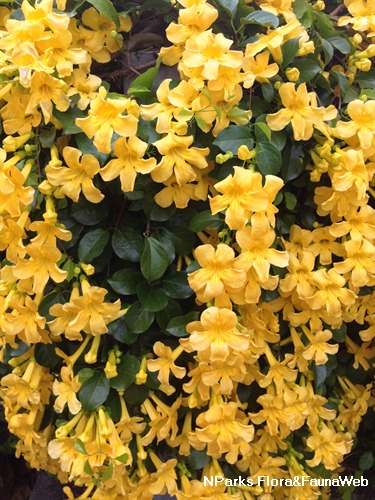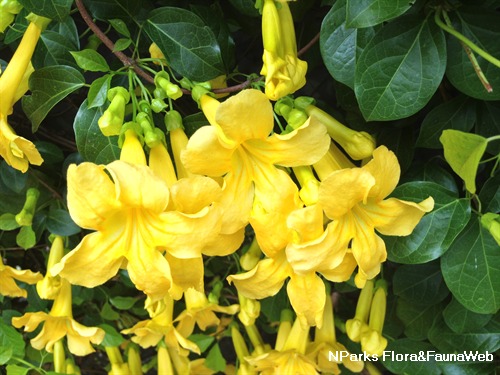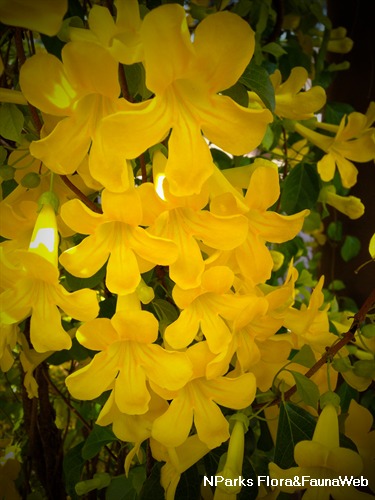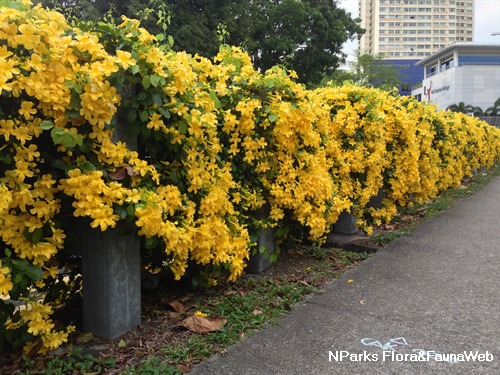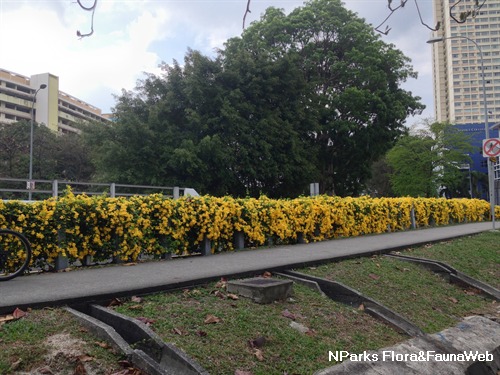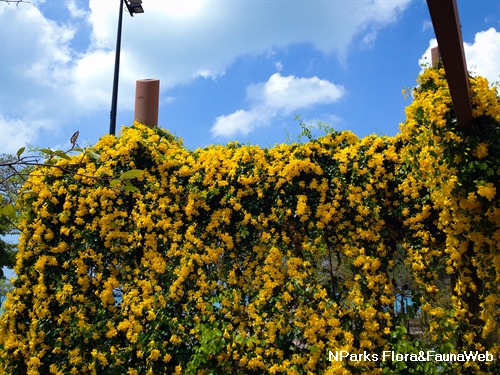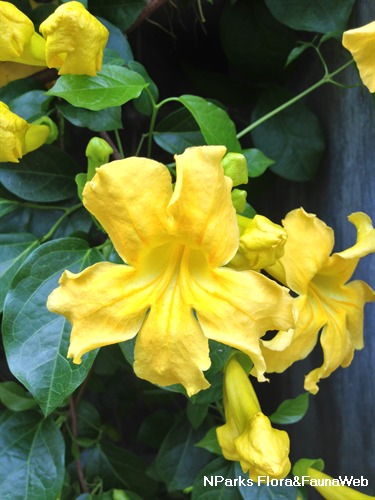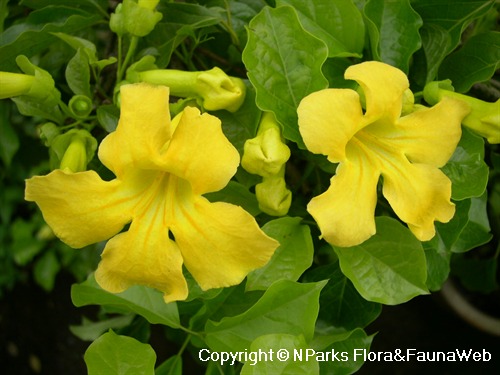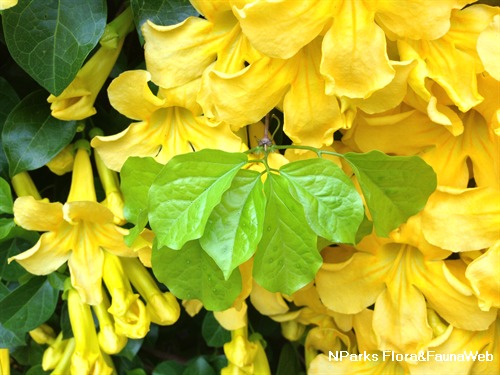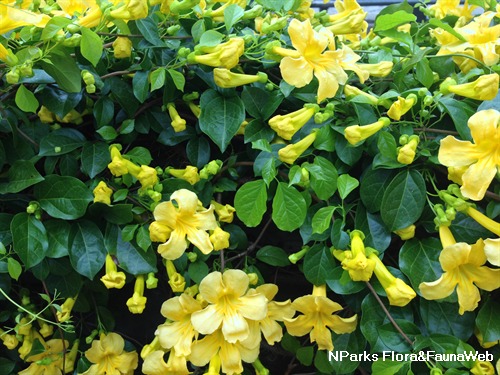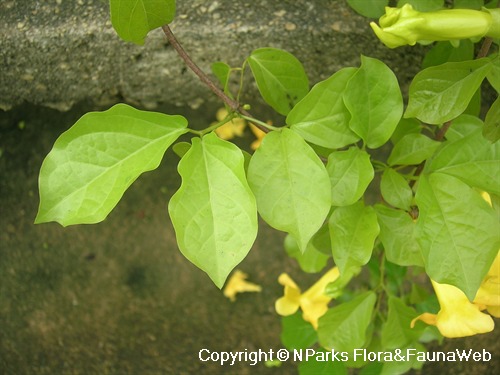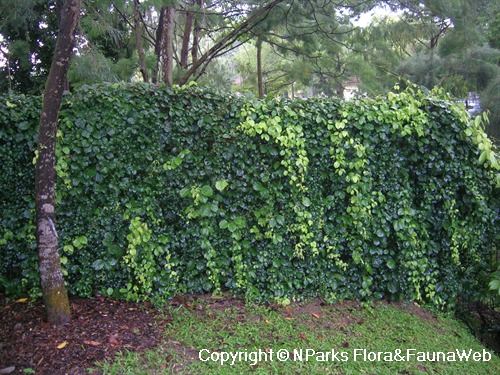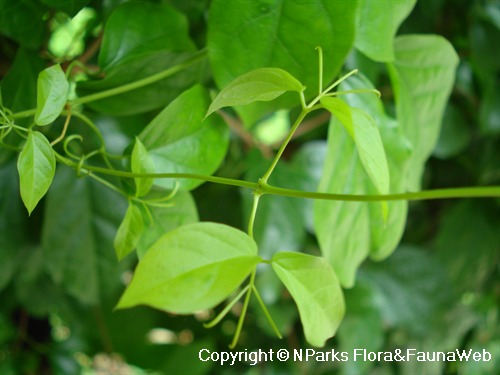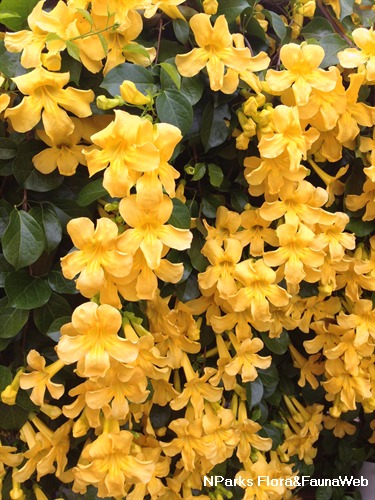
Back
Dolichandra unguis-cati (L.) A. Gentry
| Family Name: | Bignoniaceae |
| Synonyms: | Macfadyena unguis-cati, Bignonia unguis-cati |
| Common Name: | Anikab, Bejuco, Edmurcielago, Mano de Lagarija, Cat Claw Ivy, 猫爪藤 |
Name
Classifications and Characteristics
| Plant Division | Angiosperms (Flowering Seed Plants) (Dicotyledon) |
|---|---|
| Plant Growth Form | Climber |
| Lifespan (in Singapore) | Perennial |
| Mode of Nutrition | Autotrophic |
Biogeography
| Native Distribution | Tropical America |
|---|---|
| Native Habitat | Terrestrial |
| Local Conservation Status | Non-native (Horticultural / Cultivated Only) |
Description and Ethnobotany
| Growth Form | A woody vine, it climbs by means of claw-shaped leaf tendrils and adventitous roots. |
|---|---|
| Roots | The roots produce tubers which produce runners. |
| Foliage | The compound leaves are arranged in opposite pairs along the stems. Each leaf consists of 2 leaflets and a terminal 3-clawed tendril. The leaflets are ovate to lanceolate, 3-7 cm long, with an entire margin. |
| Flowers | The yellow flowers are trumpet-shaped, 7 by 10 cm, borne in clusters at the leaf axils. The corolla is 5-lobed and yellow with orange lines running along the length of the corolla tube. |
| Fruit | The fruit is a linear, flat capsule, up to 50 cm long, with oblong, winged seeds. |
| Habitat | It is found in tropical and pre-montane forests, at sea level to 600m in altitude. |
| Cultivation | It can be propagated by seed. |
| Etymology | Macfadyena, after James Macfadyen (1799–1850), a Scottish doctor and botanist who studied the plants of the Caribbean region; Latin unguis-cati, cat's-clawed, referring to the claw-like tendrils. |
Landscaping Features
| Landscaping | It is suitable for parks and gardens, on trellis and pergolas for its bright yellow flowers. |
|---|---|
| Desirable Plant Features | Ornamental Flowers |
| Landscape Uses | Parks & Gardens, Vertical Greenery / Green Wall, Trellis / Arbour / Pergola |
| Thematic Landscaping | Golden Garden |
| Usage Hazard - Cons | Invasive / Potentially Invasive |
Fauna, Pollination and Dispersal
| Pollination Method(s) | Biotic (Fauna) |
|---|---|
| Seed or Spore Dispersal | Abiotic |
Plant Care and Propagation
| Light Preference | Semi-Shade, Full Sun |
|---|---|
| Water Preference | Moderate Water |
| Plant Growth Rate | Fast |
| Rootzone Tolerance | Drought Tolerant, Moist Soils, Well-Drained Soils, Fertile Loamy Soils |
| Propagation Method | Seed, Stem Cutting, Storage Organ (Root Tuber), Division |
Foliar
| Foliage Retention | Evergreen |
|---|---|
| Mature Foliage Colour(s) | Green |
| Mature Foliage Texture(s) | Leathery |
| Foliar Type | Compound |
| Foliar Arrangement Along Stem | Opposite |
| Foliar Attachment to Stem | Petiolate |
| Foliar Shape(s) | Non-Palm Foliage (Ovate, Lanceolate) |
| Foliar Venation | Pinnate / Net |
| Foliar Margin | Entire |
Non - Foliar and Storage
| Root Type | Underground, Aboveground (Aerial Root) |
|---|
Floral (Angiosperm)
| Flower & Plant Sexuality | Bisexual Flowers |
| Flower Colour(s) | Yellow / Golden, Orange |
|---|---|
| Flower Grouping | Cluster / Inflorescence |
| Flower Location | Axillary |
| Individual Flower Shape | Trumpet-shaped |
Fruit, Seed and Spore
| Mature Fruit Colour(s) | Brown |
|---|---|
| Fruit Classification | Simple Fruit |
| Fruit Type | Dehiscent Dry Fruit , Capsule |
Image Repository
Others
| Master ID | 148 |
|---|---|
| Species ID | 1444 |
| Flora Disclaimer | The information in this website has been compiled from reliable sources, such as reference works on medicinal plants. It is not a substitute for medical advice or treatment and NParks does not purport to provide any medical advice. Readers should always consult his/her physician before using or consuming a plant for medicinal purposes. |

